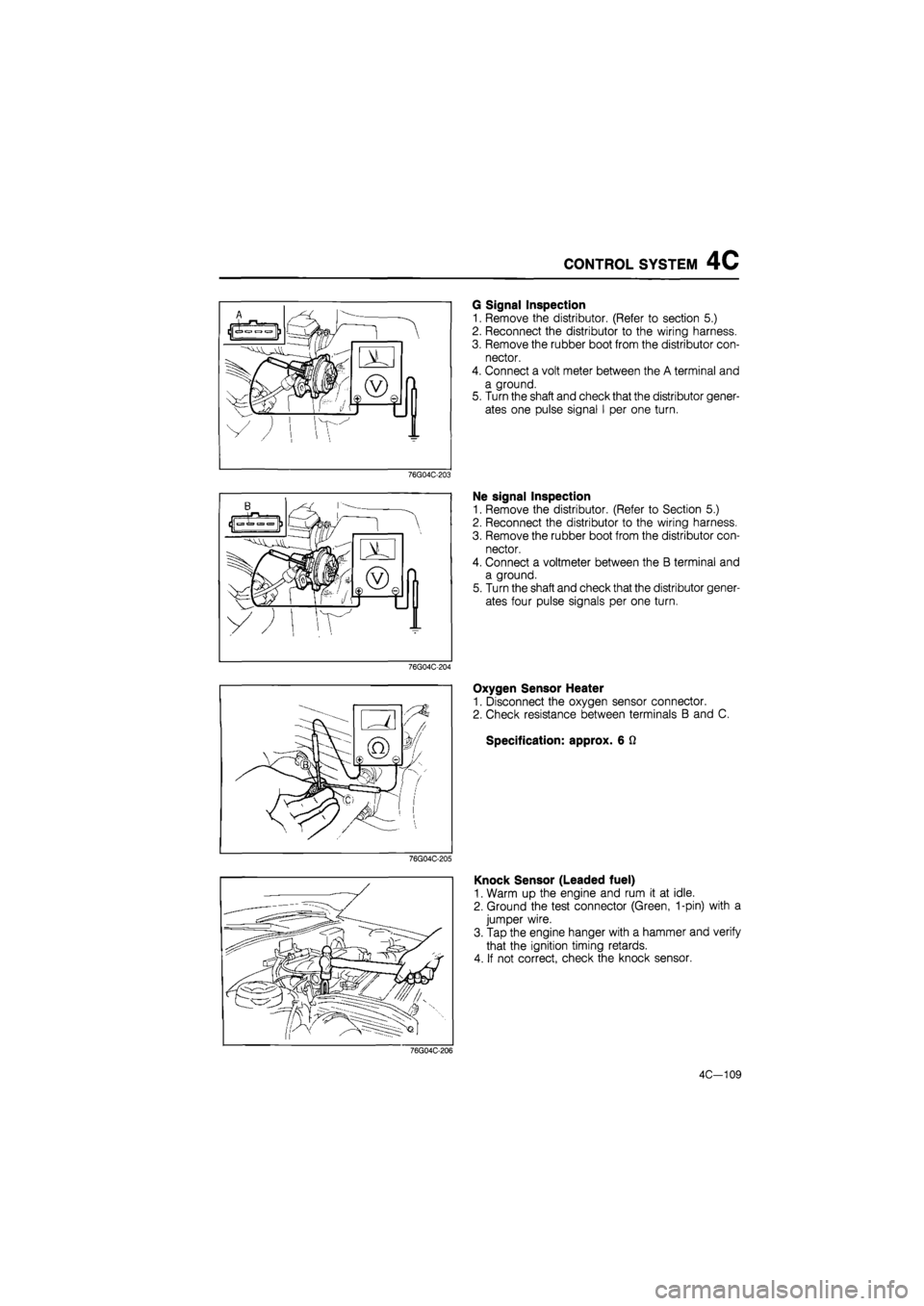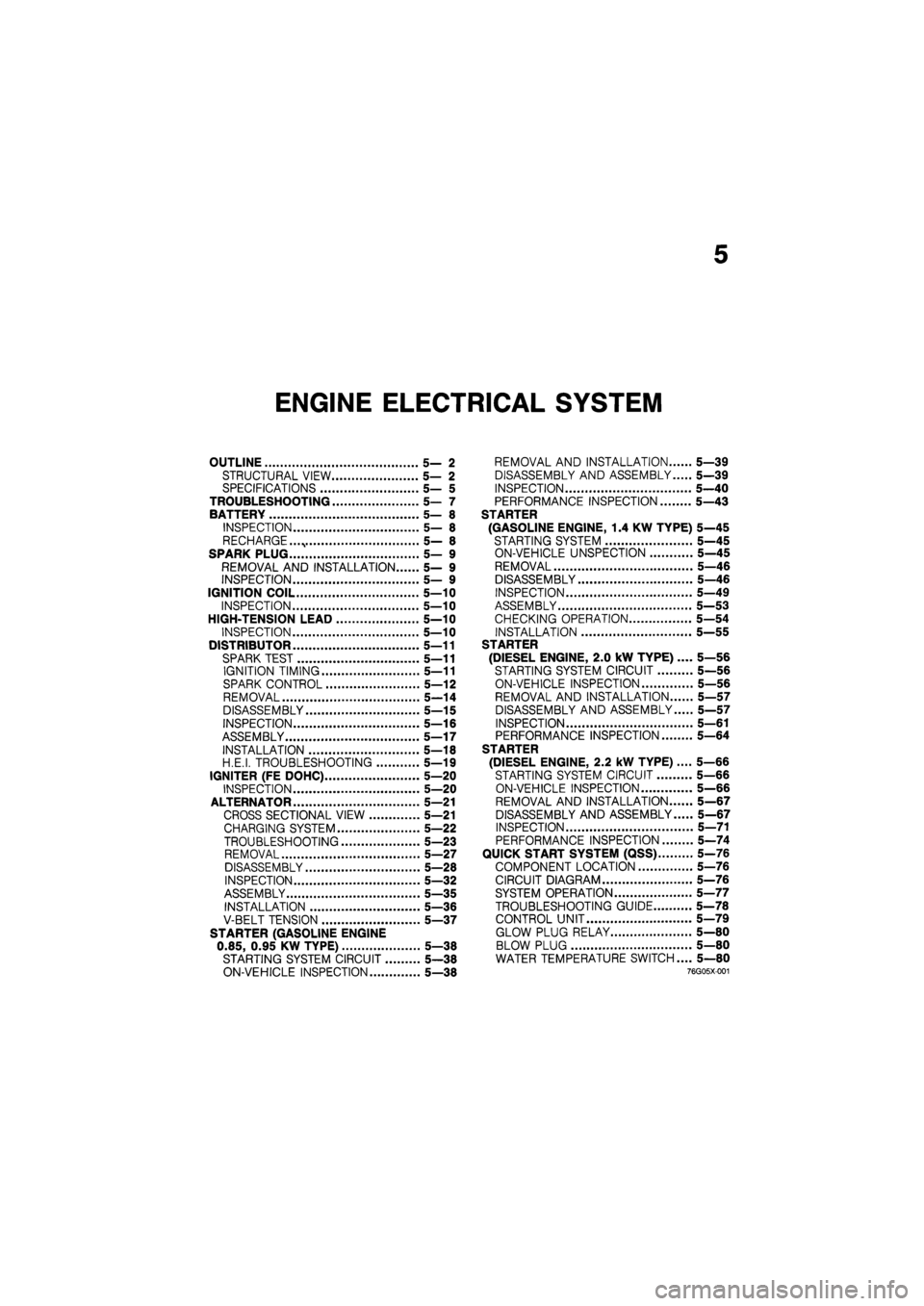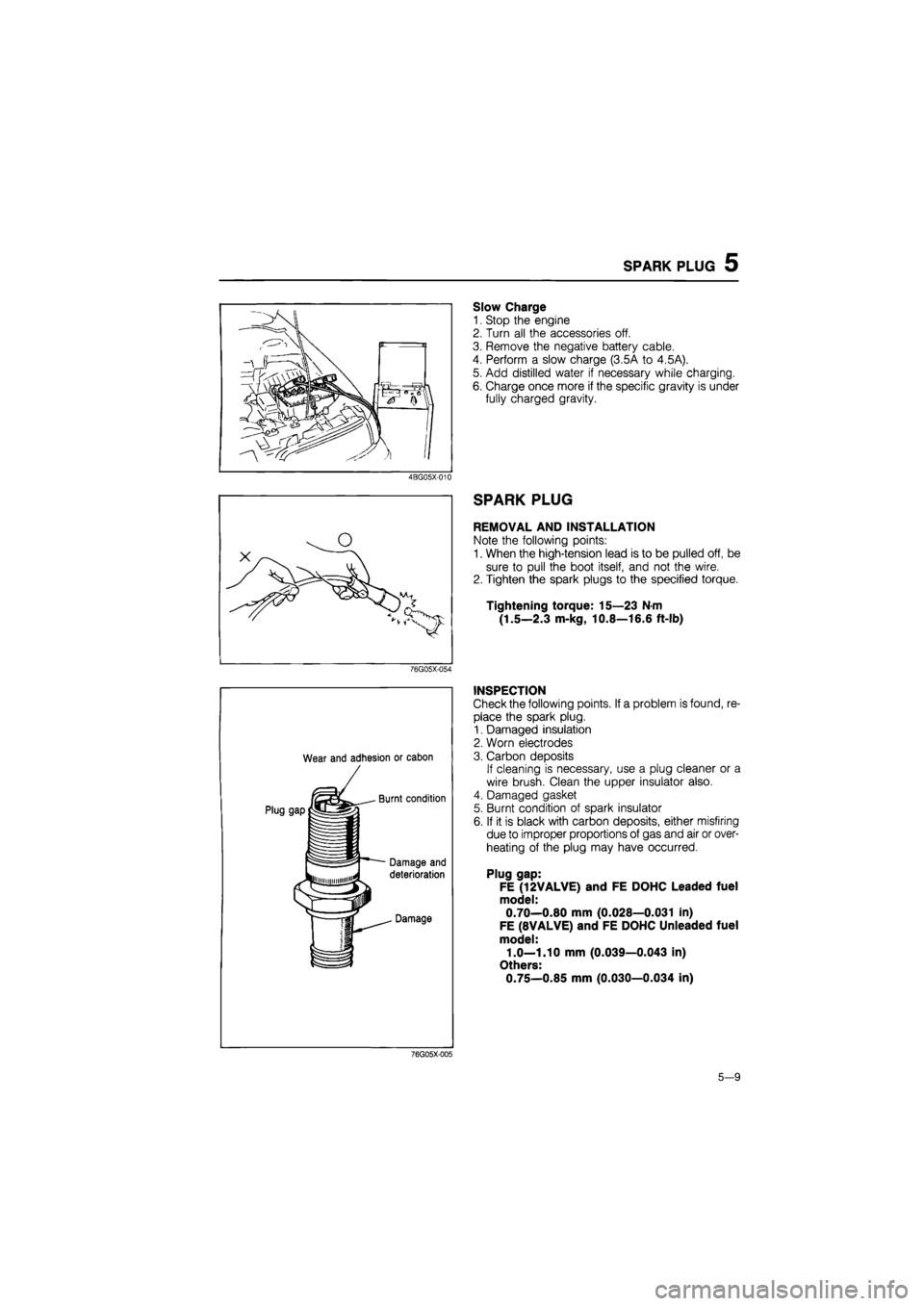1987 MAZDA 626 check engine
[x] Cancel search: check enginePage 670 of 1865

CONTROL SYSTEM 4C
76G04C-203
76G04C-204
76G04C-205
G Signal Inspection
1. Remove the distributor. (Refer to section 5.)
2. Reconnect the distributor to the wiring harness.
3. Remove the rubber boot from the distributor con-
nector.
4. Connect a volt meter between the A terminal and
a ground.
5. Turn the shaft and check that the distributor gener-
ates one pulse signal I per one turn.
Ne signal Inspection
1. Remove the distributor. (Refer to Section 5.)
2. Reconnect the distributor to the wiring harness.
3. Remove the rubber boot from the distributor con-
nector.
4. Connect a voltmeter between the B terminal and
a ground.
5. Turn the shaft and check that the distributor gener-
ates four pulse signals per one turn.
Oxygen Sensor Heater
1. Disconnect the oxygen sensor connector.
2. Check resistance between terminals B and C.
Specification: approx. 6 Q
Knock Sensor (Leaded fuel)
1. Warm up the engine and rum it at idle.
2. Ground the test connector (Green, 1-pin) with a
jumper wire.
3. Tap the engine hanger with a hammer and verify
that the ignition timing retards.
4. If not correct, check the knock sensor.
76G04C-206
4C-109
Page 677 of 1865

4D ON-VEHICLE MAINTENANCE
IDLE SPEED
1. Warm up the engine to normal operating tem-
perature.
2. Be sure the A/C switch is OFF.
3. Connect a tachometer and check the engine
speed.
Idle speed: 720 :
20
rpm
76G04D-012
4. If necessary, adjust the idle by turning the idle ad-
justing screw.
76G04D-013
Fast Idle Speed (A/C equipped model)
1. Turn ON the A/C switch and blower motor switch.
2. Check the engine speed.
Fast idle speed: 725 ± 25 rpm
3. If necessary, turn the adjusting screw on the idle-
up actuator, and adjust the fast idle speed.
76G04D-014
EXHAUST SMOKE
Increase and decrease the engine speed several
times and check that there is no black smoke.
If
there
is, refer to the Troubleshooting Guide.
76G04D-015
4D—6
Page 682 of 1865

4D SUPERCHARGING SYSTEM (RF-CX)
ON-VEHICLE INSPECTION
Boost Pressure
1. Connect a pressure gauge to the hose from the
intake manifold.
2. (On chassis dynomometer, full load)
(1) Set the vehicle on a chassis dynomometer.
(2) Run the vehicle in gear at 3,000 rpm with the
acceleration pedal fully depressed.
(3) Measure the boost pressure.
Boost pressure:
82 kPa (0.87 kg/cm2, 8.1 psi)
Note
The above inspection should be done on a
chassis dynomometer. If a dynomometer is
not available follow the below procedure.
3. (Off chassis dynomometer, no load)
(1) Shift the transaxle out off gear.
(2) Run the engine in neutral at 3,000 rpm of the
engine no load.
Measure the boost pressure.
Boost pressure:
5 kPa (0.05 kg/cm2, 0.7 psi)
Note
The boost pressure is varied by engine speed
and engine load.
(3) Remove the starting valve bypass hose.
(4) Check that the bypass valve is closed at 3,000
rpm.
4.
If
the pressure is below specification, check the fol-
lowing. Replace the Comprex supercharger if
necessary.
(1) Intake air and exhaust passages leakage
(2) Intake air and exhaust passages clogged
(3) Wastegate (Refer to 4D—12.)
(4) Starting valve (Refer to 4D—15.)
(5) Fuel system (Injection nozzle... refer to page
4D—31, injection pump...refer to page 4D—24,
etc.)
5. If the pressure exceeds specification, check the
wastegate operation. (Refer to page 4D—12.)
4D—11
Page 695 of 1865

4D FUEL SYSTEM
INJECTION PUMP
On-Vehicle Inspection
Fuel cut solenoid valve
1. Run the engine at idle.
2. Disconnect the solenoid valve connector, and let
the engine stop.
3. If the engine does not stop, replace the fuel cut
solenoid valve.
76G04D-055
Pick up coil
1. Disconnect the pick up coil connector.
2. Check for continuity of the coil using an ohmmeter.
3. Replace it if there is not continuity.
76G04D-056
O
o
>=
=<
t= —i V
' 1 -4
n
5-
U
o
1 mm (0.39 in) Injection Timing Adjustment
Inspection
Check the injection timing. (Refer to page 4D—5.)
Injection timing
RF-CX: ATDC 10
RF-N : TDC 0°
76G04D-057
Adjustment
1. Loosen the injection pump mounting nut.
2. Loosen the injection pump bracket bolt.
76G04D-058
4D—24
Page 701 of 1865

o
GO o
VE-TYPE RF79 13 800A: 104748-0343 For RF-N ENGINE
£ TEST OIL SAE Standard test oil (SEA 967C)
Fuel injection amount Chamber pressure and timer stroke Load sensing timer and overflowing quantity Measurenment
Item Pump speed (RPM)
Fuel injection amount
(cm3/stroke)
Start 100 More than 42/1,000
Full load
600 29.0—33.0/1,000
Full load
1.375 34.9—36.9/1,000
Full load 2,325 30 2—34.2/1,000 Full load
2,600 9.8—15 8/1,000
Full load
2,700 Max. 6 0/1,000
Idling 360 8-12/1,000
Pump speed (RPM) Chamber pressure
(kg/cm2)
Timer stroke
(mm)
600 2 2—2.8
1,375 4 4—5,0 3 9—4.5
1,800 5 6—6.2 6.1-7.3
2.325 6.9—7.5 7.2—8.4
Item Fuel injectioon amount
(cm3/stroke)
Load sens- Start 26.7-29.7/1,000
ing timer End 14.6—17.6/1,000
Overflowing quantity 46.3—90.3/1.000
'Checking condition
Pump speed: 1,375 rpm
Lever: Full load
Measuring place Dimension (mm)
KF 5.8—5.9
K 3.2—3 4
MS 1.4—1.6
c
o'
3 03 3 o c 3
O 3
o o o
o
CD
50
40
30
20
10
r
10
100 600
o o
1,375 1,800
Injection pump speed RPM
2,325 2,600 2,700
H -D
u -1 T3 52. ° ? T1
CD (0 (A c ®
"3? CD o" 3
(D O r* o 3
u C 3 "O
O 3" 0) ^ 0> o CO
a o
3 •n
m i-
co •<
(/> H m
Page 707 of 1865

5
ENGINE ELECTRICAL SYSTEM
OUTLINE 5— 2
STRUCTURAL VIEW 5— 2
SPECIFICATIONS 5— 5
TROUBLESHOOTING 5— 7
BATTERY 5— 8
INSPECTION 5— 8
RECHARGE. 5— 8
SPARK PLUG 5— 9
REMOVAL AND INSTALLATION 5— 9
INSPECTION 5— 9
IGNITION COIL 5—10
INSPECTION 5—10
HIGH-TENSION LEAD 5—10
INSPECTION 5—10
DISTRIBUTOR 5—11
SPARK TEST 5—11
IGNITION TIMING 5—11
SPARK CONTROL 5—12
REMOVAL 5—14
DISASSEMBLY 5—15
INSPECTION 5—16
ASSEMBLY 5—17
INSTALLATION 5—18
H.E.I. TROUBLESHOOTING 5—19
IGNITER (FE DOHC) 5—20
INSPECTION 5—20
ALTERNATOR 5—21
CROSS SECTIONAL VIEW 5—21
CHARGING SYSTEM 5—22
TROUBLESHOOTING 5—23
REMOVAL 5—27
DISASSEMBLY 5—28
INSPECTION 5—32
ASSEMBLY 5—35
INSTALLATION 5—36
V-BELT TENSION 5—37
STARTER (GASOLINE ENGINE
0.85, 0.95 KW TYPE) 5—38
STARTING SYSTEM CIRCUIT 5—38
ON-VEHICLE INSPECTION 5—38
REMOVAL AND INSTALLATION 5—39
DISASSEMBLY AND ASSEMBLY 5—39
INSPECTION 5—40
PERFORMANCE INSPECTION 5—43
STARTER
(GASOLINE ENGINE, 1.4 KW TYPE) 5—45
STARTING SYSTEM 5—45
ON-VEHICLE UNSPECTION 5—45
REMOVAL 5—46
DISASSEMBLY 5—46
INSPECTION 5—49
ASSEMBLY 5—53
CHECKING OPERATION 5—54
INSTALLATION 5—55
STARTER
(DIESEL ENGINE, 2.0 kW TYPE) .... 5—56
STARTING SYSTEM CIRCUIT 5—56
ON-VEHICLE INSPECTION 5—56
REMOVAL AND INSTALLATION 5—57
DISASSEMBLY AND ASSEMBLY 5—57
INSPECTION 5—61
PERFORMANCE INSPECTION 5—64
STARTER
(DIESEL ENGINE, 2.2 kW TYPE).... 5—66
STARTING SYSTEM CIRCUIT 5—66
ON-VEHICLE INSPECTION 5—66
REMOVAL AND INSTALLATION 5—67
DISASSEMBLY AND ASSEMBLY 5—67
INSPECTION 5—71
PERFORMANCE INSPECTION 5—74
QUICK START SYSTEM (QSS) 5-76
COMPONENT LOCATION 5—76
CIRCUIT DIAGRAM 5—76
SYSTEM OPERATION 5—77
TROUBLESHOOTING GUIDE 5—78
CONTROL UNIT 5—79
GLOW PLUG RELAY 5—80
BLOW PLUG 5—80
WATER TEMPERATURE SWITCH.... 5—80
76g05x-001
Page 713 of 1865

TROUBLESHOOTING GUIDE 5
TROUBLESHOOTING GUIDE
Problem Possible cause Remedy Page
Starter does not turn at all, or Its turning speed Is too slow to start the engine.
Battery and related parts Poor contact of battery terminals Poor grounding of negative cable Voltage drop caused by discharged battery Insufficient voltage caused by battery malfunction
Clean and tighten Clean and repair Recharge Replace
5- 8
5- 8 5- 8
Ignition switch and related parts Poor contact of ignition switch Loose ignition switch wiring or connector Broken wire between ignition switch and magnetic switch
Replace Repair Repair or replace 5-38,45,56,66
Magnetic switch and related parts Loose wiring and/or connectors Burnt magnetic switch contact plate or improper contact Broken wire in magnetic switch pull-in coil Broken wire magnetic switch holding coil
Repair Replace
Replace Replace
5-38,45,56,66 5-43,54,64,74
5-43,54,64,74 5-43,54.64,74
Starter Poor contact of brushes
Fatigued brush spring Poor grounding of field coil Poor soldering of field coil Commutator mulfunction Grounded armature Worn parts
Adjust contact or replace Replace Replace Repair Repair or Replace Replace Replace
5-43,54,64,74
Starting problem Gasoline engine Insufficient battery capacity Malfunction of spark plug (s)
Loose positive terminal Damaged distributor cap or rotor Ignition coil malfunction laniter malfunction
Recharge Clean, adjust or replace Tighten Replace Replace Renlane
5— 8 5— 9
5—16 5—10 5-16,20
Diesel engine Insufficient battery capacity QSS svstem malfunction Recharge ReDlace 5— 8 5-76
Starter turns but pinion gear does not mesh with ring gear
Starter Tip of overrunning clutch pinion is worn Weakened overrunning clutch drive spring Worn overrunning clutch Improper sliding of spline
Worn bushing Worn ring gear
Replace Replace Replace Adjust contact and repair, or replace Replace ReDlace
5-40,54,70
Starter turns continuously (does not stop) Magnetic switch Sticking contact place of magnetic switch Layer shorting coil of magnetic switch Ignition switch does not return
Replace Replace Rfinlanfi
5-43,54,64,74 5-43,54,64,74
Misfiring Dirty or damaged spark plug (s) Malfunction of wiring, or open circuit Damaged distributor cap
Clean or replace Repair or Replace Replace
5- 9 5—10 5—16
Discharging of battery Alternator Loose drive belt Grounded or broken stator coil Broken rotor coil Poor contact of brush and slip ring
Malfunction of rectifier Malfunction of IC regulator Battery and related parts Insufficient or unsuitable battery electrolyte Malfunction of battery electrode (internal short-circuit) Poor contact of battery terminal (s) Excessive electric load
Adjust Replace Replace Clean, repair or replace Replace Replace
Adjust Replace
Clean and tighten Check power consump-tion and short circuit
5-37 5-32 5-32 5-32
5-34
5— 8 5- 8
5— 8
Overcharging of battery IC regulator malfunction Operating in extremely high temperature Replace Reoair
Poor acceleration Mis-adjusted ignition timing Distributor malfunction Adjust Repair or replace 5—11 5—11
Knocking Mis-adjusted ignition timing | Distributor malfunction Adjust Repair or replace 5—11 5—11
76G05X-003
5-7
Page 715 of 1865

SPARK PLUG 5
Slow Charge
1. Stop the engine
2. Turn all the accessories off.
3. Remove the negative battery cable.
4. Perform a slow charge (3.5A to 4.5A).
5. Add distilled water if necessary while charging.
6. Charge once more if the specific gravity is under
fully charged gravity.
4BG05X-010
SPARK PLUG
REMOVAL AND INSTALLATION
Note the following points:
1. When the high-tension lead is to be pulled off, be
sure to pull the boot itself, and not the wire.
2. Tighten the spark plugs to the specified torque.
Tightening torque: 15—23 N-m
(1.5—2.3 m-kg, 10.8—16.6 ft-lb)
76G05X-054
Wear and adhesion or cabon
INSPECTION
Check the following points. If a problem is found, re-
place the spark plug.
1. Damaged insulation
2. Worn electrodes
3. Carbon deposits
If cleaning is necessary, use a plug cleaner or a
wire brush. Clean the upper insulator also.
4. Damaged gasket
5. Burnt condition of spark insulator
6. If it is black with carbon deposits, either misfiring
due to improper proportions of gas and air or over-
heating of the plug may have occurred.
Plug gap:
FE (12VALVE) and FE DOHC Leaded fuel
model:
0.70—0.80 mm (0.028—0.031 in)
FE (8VALVE) and FE DOHC Unleaded fuel
model:
1.0—1.10 mm (0.039—0.043 in)
Others:
0.75—0.85 mm (0.030—0.034 in)
76G05X-005
5-9